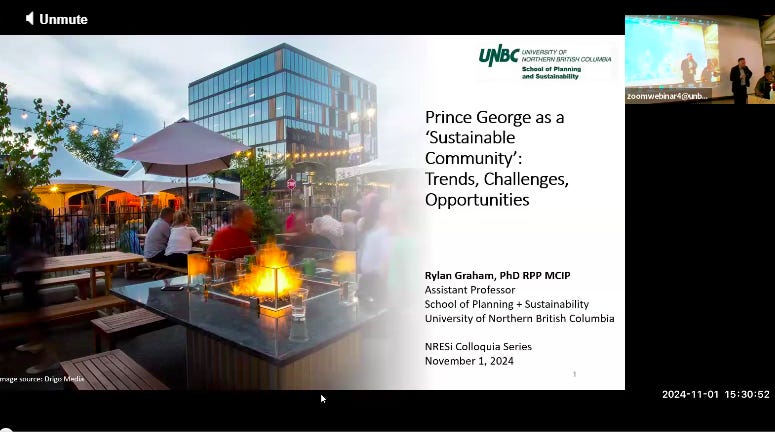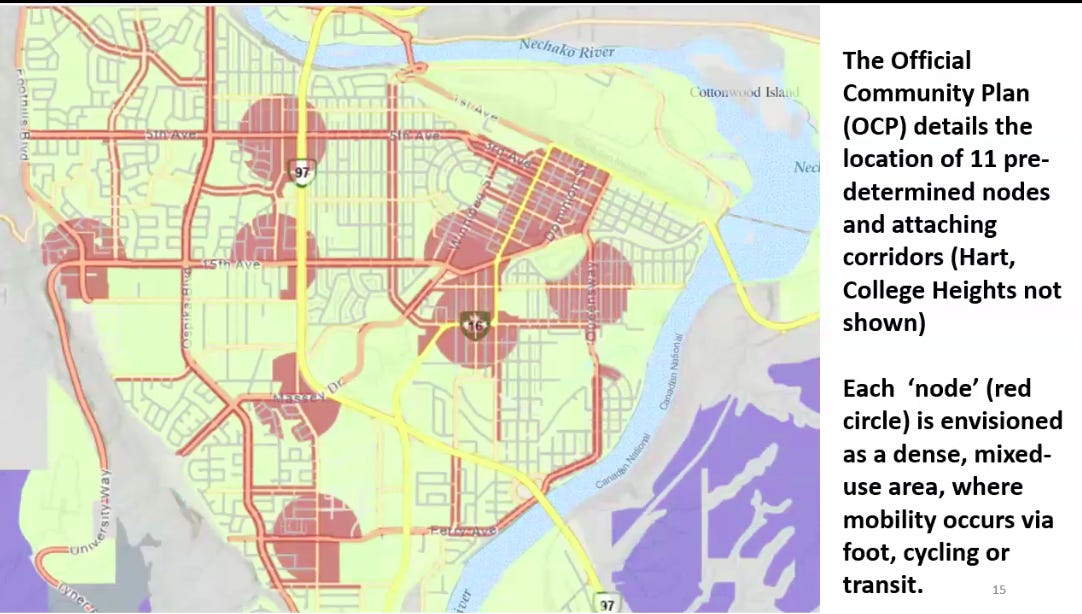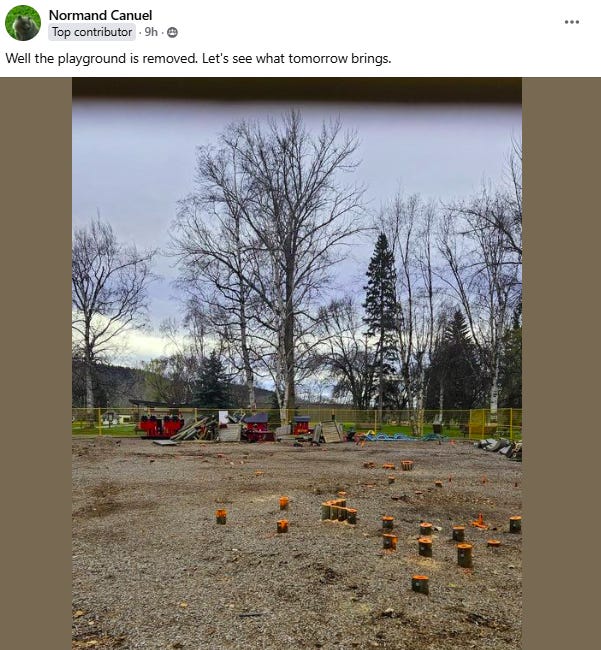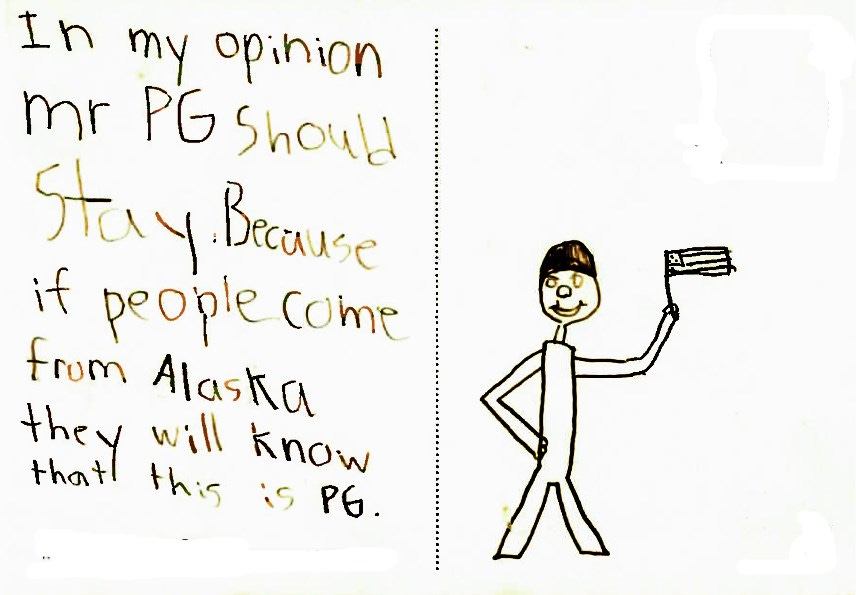In 25 years, downtown Prince George has only grown by 50 people. How can we change that?
Plus, a zipline to work. Read to the end for a child's drawing of Mr. PG
In the comments section, Mandi shared a link to last week’s UNBC presentation “Prince George As A Sustainable Community: Trends, Challenges and Opportunities” by Rylan Graham, an assistant prof of planning and sustainability. You can watch it here:
It fits very nicely into this week’s theme of tackling issues on a local scale as he dives into the growth of Prince George as a sprawl of suburbs, eating into greenspace and a hollowed out downtown — and what can be done to counter that, based on the experiences of other similar cities that have seen a reversal of that trend (and encountered a younger demographic as a result). Obviously, you should just watch it if you want the whole thing, and I do think it’s worth the time, but I did take notes of some highlights:
Broadly speaking, Prince George followed the same 20th century trend of suburbanization as most other North American cities
Once upon a time, downtown was dense and walkable, with theatres, restaurants, shops and homes in a few city blocks. Over time we — like most other cities — spread out and out, increasing car dependency and reducing the number of people downtown. One major difference is the extent to which Prince George spread out — 329 square kilometres versus the 90 square kilometres that make up Nanaimo’s city limits, by way of example — without the projected boom to more than 120,000 people planners thought we would have reached by now.
Here’s a map from the presentation using Stats Canada data that the Toronto School of Cities made showing the parts of Prince George that have increased their population (blue dots) and those that have decreased (red) from 1996 to 2021. You might notice a trend:
90 per cent of Prince George residents commute by car
That’s highter than averages.
The city actually has areas for targeted growth in its community plans
The goal, Graham says, is not to stop growth but to focus it through intensification — filling in empty lots, putting in higher-density housing, creating communities that are more centralized that can support more services and a better sense of neighbourhood than currently exists. And, he shared something I didn’t know: the city has not only adopted this goal (I knew this) but it has identified several key areas where this should be done (this I did not). Here they are:
The tough part, of course, is actually doing that. To whit:
Downtown’s population has only increased by 50 people in the last 25 years
Again, using Stats Can data. Despite literal decades of planning documents and official community plans focused on wanting to increase people living near the city’s core, there’s been a net increase of 50 people.
Young people want to live in a downtown, but not ours
The next part of the presentation was largely focused on a paper Graham published in 2022 titled “Do young adults want to live downtown? Understanding attitudes in Prince George, B.C.” Since it’s both an article you can read and a portion of the presentation I’ll summarize it as above — young people, generally, want to live in vibrant downtowns and of the hundreds of young people he surveyed in Prince George while many liked the idea of living in such a place, they did not see Prince George’s downtown as a viable option. The result? Many will move elsewhere. This has been a problem identified by other communities, as well, as some cities thrive and others decline.
My only other note is that when he was trying to find young people to take part in the survey and was reaching out on Facebook and Twitter he had very little response, but once that moved to TikTok and Instagram, the responses started pouring in… in case you’re wondering how to reach young people.
Here’s what can be done
Again, watch the presentation but I did want to write out his seven steps for improvement, based in part on the experiences of the fastest-growing cities in the country — Halifax, Kitchener, and Kelowna in particular.
They are:
Disincentive urban sprawl — or stop building news suburbs. It’s very easy in Prince George to build on greenspace. The challenge is to stop doing so. In some cities, council has literally drawn borders around the areas it wants to grow, and said no new building outside those lines.
Make it easier to build intensification. Going back to the map, above, where the city has identified a desire to have more people living, Graham says he and his research assistants have found zoning bylaws are such that it’s actually very difficult to build high-density housing. So that seems like something that should be tackled.
Build complete communities: basically, places where people want to shop, play, work and live.
Maintain public investment downtown — this is an area Graham said the city is doing good work, committing to things like the new pool and tourism centre downtown, and the ongoing project of figuring out what to do with the space occupied by the former pool and fire station.
Have advocates. There need to be people in the community speaking to city hall — or in city hall — pushing to make all of the above and below happen.
Meet the market: the condos outside city hall still have units for sale. Why? In part, because they are expensive. That’s not the kind of housing the city needs, and especially not the kind that is going to appeal to the younger demographic most likely to want to live downtown. For that, we need affordable, below-market and rental housing.
Find the right kind of developers. This was one I’d never considered before, but building the kind of housing needed is specialized, whereas the established developers operating in PG are the ones who’ve learned how to do what we’ve always done — build new, suburban-style neighbourhoods on the outskirts of the city. For things like towers, row-homes, etc we need to be reaching out to people who build in your Vancouvers and Kelownas and get them to do the same here.
There was also a Q&A session and one that I thought was particularly interesting was whether our downtown is defined broadly enough— the asker suggested, for example, that while Parkwood is right there it often seems to be spoken of as if it is not part of the downtown, as if we don’t have a downtown theatre or the restaurants and shops that are there aren’t a part of downtown, either, further perpetuating the popular notion that “there is nothing downtown.” Graham said he’s not sure he agrees and suggested perhaps the issue is downtown is too big — with things to spread out from each other to make it feel walkable, especially given the large gaps. In this answer he also said a challenge is that Prince George’s downtown is tucked away in the northeast corner of the city as opposed to being at the centre of the footprint — something that I’ve though of before, and I’m sure you have too. Nothing to be done about that, I suppose, but a consideration.
So yeah, those are my notes. Again, though, it’s a long weekend and you can watch the full presentation here.
Remembrance Day and Indigenous Veterans Day
Today is Indigenous Veterans Day and Monday is Remembrance Day. For the former, the Legion is hosting a dinner tonight and a full day of ceremonies Monday.
A few stories/interviews:
The Importance of Remembrance Day - Prince George Legion Branch 43.
Recognizing veterans past and present with the Rocky Mountain Rangers.
News roundup:
Prince George RCMP seek man accused of assaulting police, burglary.
Sweeney Todd brings veteran performers and raw talent to the stage.
Nearly $3,000 raised for youth groups through Prince George Haunted House.
Tree of Lights ready to light up Prince George for United Way.
Xatsull First Nation calls for new gold mine project near Wells to be halted.
City plans to pursue provincial funding to pay for capital projects.
Northern Capital News is a free, daily newsletter about life in Prince George. Please consider subscribing or, if you have, sharing with someone else.
Send feedback by emailing northerncapitalnews@gmail.com. Find me online at akurjata.ca.











The next phase (consisting of two new buildings) will actually be rental housing, and is being built by a different developer. There’s definitely a stronger market for downtown rentals than condos.
The Mr PG drawing added a much needed smile to my day. Thank you!